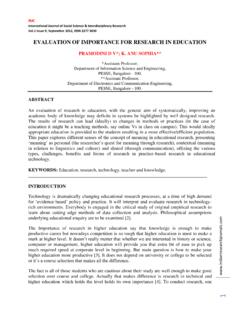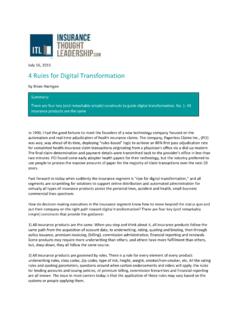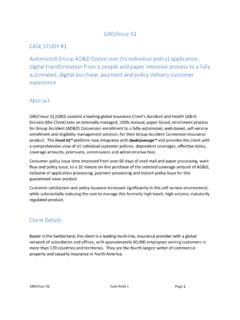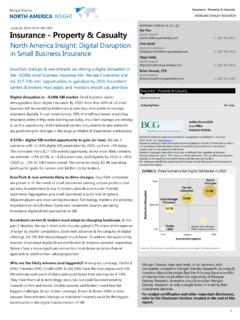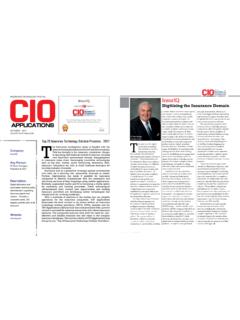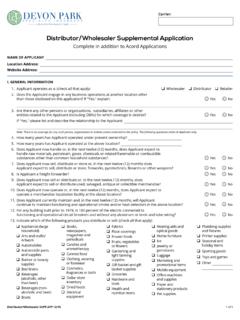Transcription of MARKETING STRATEGIES IN LIFE INSURANCE SERVICES
1 International Journal of MARKETING , Financial SERVICES & Management Research Issue 11, November 2012, ISSN 2277 3622 Online available at 132 MARKETING STRATEGIES IN life INSURANCE SERVICES BEENISH SHAMEEM *; DR SAMEER GUPTA ** * RESEARCH SCHOLAR, THE BUSINESS SCHOOL, UNIVERSITY OF JAMMU ** ASSOCIATE PROFESSOR, THE BUSINESS SCHOOL, UNIVERSITY OF JAMMU ABSTRACT The study is designed to evaluate the MARKETING STRATEGIES in life INSURANCE service sector & how these STRATEGIES boost sales & marketability of a product which ultimately lead to customer satisfaction. The INSURANCE scenario faces multiple challenges such as increased costs of operation, regulatory pressures, and inflexible technology infrastructure. These pressures are compounded by low to moderate premium growth & the increasing burdens of regulatory compliance.
2 Keeping all the above problems around the study would attempt to study all the factors that contributed to the effective MARKETING STRATEGIES . This paper presents different MARKETING STRATEGIES that are taken up in life INSURANCE SERVICES keeping in view external and internal environment of the firm. MARKETING strategy is the basic approach that the business units will use to achieve its objectives, and it consists of broad decisions on target markets, market positioning and mix, and MARKETING expenditure levels. As the financial SERVICES sector has become more competitive, financial institutions need to consider ,ways of developing relationships with their existing customers in order to defend their market share.
3 Strategic dimension of MARKETING should focus on the direction that an organization would take in relation to a specific market or set of markets in order to achieve a specified set of objectives. Every insurer must recognize that its "strategic posture" depends partly on the competitive environment, partly on its allocation of MARKETING resources. An INSURANCE firm strategy is a plan for action that determines how an insurer can best achieve its goals and objectives in the light of the existing pressures exerted by competition, on the one hand, and its limited resources on the other hand. KEYWORDS: Customer satisfaction, INSURANCE , Innovation, MARKETING STRATEGIES , SERVICES . _____ INTRODUCTION In today s economy, the financial SERVICES industry is exposed to increasing performance pressures and competitive forces (Goergen, 2001).
4 Modern media, such as the internet, have created new challenges for this industry (Fuchs, 2001).New business concepts, a change in client sophistication (Davis, 2006), and anincreasing number of new competitors entering into the market, such as independent financial consultants, have changed the business models and the competitive forces that established financial SERVICES organizations are facing today MARKETING strategy serves as the foundation of a MARKETING plan. A MARKETING plan contains a list of specific actions required to successfully implement a specific MARKETING strategy. A International Journal of MARKETING , Financial SERVICES & Management Research Issue 11, November 2012, ISSN 2277 3622 Online available at 133 strategy is different than a tactic.
5 While it is possible to write a tactical MARKETING plan without a sound, well-considered strategy, it is not recommended. Without a sound MARKETING strategy, a MARKETING plan has no foundation. MARKETING STRATEGIES serve as the fundamental underpinning of MARKETING plans designed to reach MARKETING objectives. It is important that these objectives have measurable good MARKETING strategy should integrate an organization's MARKETING goals, policies, and action sequences (tactics) into a cohesive whole. The objective of a MARKETING strategy is to provide a foundation from which a tactical plan is developed. This allows the organization to carry out its mission effectively and efficiently. The following techniques are implemented to device the MARKETING Strategy for the product/service: Segmentation Targeting Positioning Market segmentation is the process in MARKETING of grouping a market ( customers) into smaller subgroups.
6 This is not something that is arbitrarily imposed on society: it is derived from the recognition that the total market is often made up of submarkets (called 'segments'). These segments are homogeneous within ( people in the segment are similar to each other in their attitudes about certain variables). Because of this intra-group similarity, they are likely to respond somewhat similarly to a given MARKETING strategy. That is, they are likely to have similar feeling and ideas about a MARKETING mix comprised of a given product or service, sold at a given price, distributed in a certain way, and promoted in a certain way. Segmentation: Market segmentation is widely defined as being a complex process consisting in two main phases: identification of broad, large markets Segmentation of these markets in order to select the most appropriate target markets and develop MARKETING mixes accordingly.
7 Positioning: Simply, positioning is how your target market defines you in relation to your competitors. A good position is: 1. What makes you unique? 2. This is considered a benefit by your target market International Journal of MARKETING , Financial SERVICES & Management Research Issue 11, November 2012, ISSN 2277 3622 Online available at 134 Positioning is important because you are competing with all the noise out there competing for your potential fans attention. If you can stand out with a unique benefit, you have a chance at getting their attention. It is important to understand your product from the customer s point of view relative to the competition. Targeting: Targeting involves breaking a market into segments and then concentrating your MARKETING efforts on one or a few key segments.
8 Target MARKETING can be the key to a small business s success. The beauty of target MARKETING is that it makes the promotion, pricing and distribution of your products and/or SERVICES easier and more cost-effective. Target MARKETING provides a focus to all of your MARKETING activities. MARKETING Mix: MARKETING professionals and specialist use many tactics to attract and retain their customers. These activities comprise of different concepts, the most important one being the MARKETING mix. There are two concepts for MARKETING mix: 4P and 7P. It is essential to balance the 4Ps or the 7Ps of the MARKETING mix. The concept of 4Ps has been long used for the product industry while the latter has emerged as a successful proposition for the SERVICES industry.
9 The 7Ps of the MARKETING mix that are used to frame MARKETING STRATEGIES of life INSURANCE companies can be discussed as: Product - It must provide value to a customer but does not have to be tangible at the same time. Basically, it involves introducing new products or improvising the existing products. A product means what we produce. If we produce goods, it means tangible product & when we produce & generate SERVICES , it means intangible service product. A product is both what a seller has to sell & buyer has to buy. So, INSURANCE companies sell SERVICES & SERVICES are their products. Apart from life INSURANCE as product, customer not only buys product but also SERVICES in the form of assistance & advice of agent. It is natural that customers expect reasonable returns for their investments & INSURANCE companies want to maximize their profitability.
10 Hence while deciding the product mix SERVICES or schemes should be motivational. Price - Pricing must be competitive and must entail profit. The pricing strategy can comprise discounts, offers and the like. The pricing of INSURANCE products not only affects the sales volume and profitability but also influences the perceived quality in the minds of the consumers. There are several different methods for pricing INSURANCE , based on the INSURANCE marketer s corporate objectives. They are the survival approach, the sales maximization approach, and the profit maximization approach. To determine the INSURANCE premium, marketers consider various factors such as mortality rate, investment earnings, and expenses, in addition to the individual risk profile based on age, health, etc.








